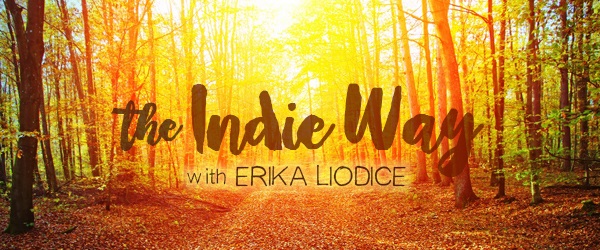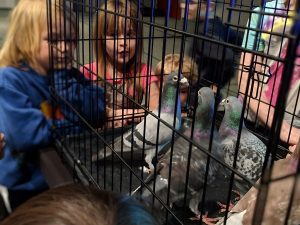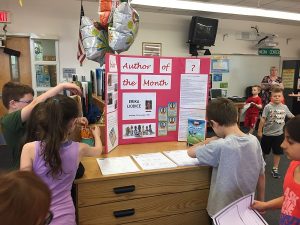How to Create an Unforgettable Author Visit
By Erika Liodice | August 25, 2018 |

I don’t remember much about elementary school, but I’ll never forget the time my favorite author, Ann M. Martin, of Baby-Sitter’s Club fame, came to visit. As she stood before my second-grade class talking about her books and writing process, I hung on every word. I still remember the answer she gave when a classmate asked where her story ideas come from: eavesdropping.
Martin’s visit has stuck with me for over 30 years. Now that I’m writing High Flyers, an illustrated chapter book series about a team of racing pigeons, and doing author visits of my own, I draw inspiration from that memory to create a rich learning experience that children will remember long after I leave. My approach was recently validated by a five-year-old boy who came up to me at a community event to tell me that I had given a presentation at his elementary school and that he enjoyed learning how to candle a racing pigeon egg to see if it’s fertilized. For a moment, I just stared at him with my mouth hanging open, stunned that my author visit had made such an impression on this young reader.
It’s not about you; it’s about them.
Creating an unforgettable author visit begins with mindset. Even though you, the author, may be the main attraction, the experience isn’t really about you; it’s about them—the students, their parents, and the school’s faculty, staff, and event coordinators. Each of these “stakeholders” wants something different from you and your presentation. Generally speaking, students want to be entertained, the parents and educators want the children to learn something, and the event coordinators want both delivered as smoothly as possible. As you develop your program, think about the different “customers” you’re serving and how you want them to feel after your presentation is over. Beginning with this end goal in mind will go a long way in helping you decide how to structure your program’s content and logistics.
 Since High Flyers is recommended for readers ages 7–10, my pet racing pigeons and I mainly visit elementary schools, home school groups, libraries, and youth organizations to teach children about the 200-year-old sport of pigeon racing and the special skills that make racing pigeons such incredible athletes. My goal for every presentation is to engage and entertain the children and support what they’re learning in the classroom, all while making the event coordinator’s job as easy as possible.
Since High Flyers is recommended for readers ages 7–10, my pet racing pigeons and I mainly visit elementary schools, home school groups, libraries, and youth organizations to teach children about the 200-year-old sport of pigeon racing and the special skills that make racing pigeons such incredible athletes. My goal for every presentation is to engage and entertain the children and support what they’re learning in the classroom, all while making the event coordinator’s job as easy as possible.
Be the resource.
Much of your event’s success rests on the event coordinator’s shoulders. When it comes to hosting an author visit, the event coordinator has a lot of details to manage before, during, and after the program. She’s responsible for finding an author who can speak on topics related to the curriculum, negotiating the contract, securing funding, promoting the event, reserving presentation space, testing the audio/visual equipment, and ensuring that everything flows smoothly the day of the event. Don’t be a diva by adding more to her plate. Instead, make it your mission to make her job as easy as possible. Anticipate her needs every step of the way and be proactive in meeting them.
One way to do this is by providing a folder that neatly organizes all of the resources needed to support your event. This should include a copy of your contract that details the logistics of your visit, including the date, time, and location of your presentation, the corresponding agenda, and a list of items you’ll need. My contract spells out who’s responsible for providing the projector, screen, power strip, extension cord, microphone, etc. To accommodate my racing pigeons, I also need a small table on which to set their cage and some open outdoor space, like a playground or field, if we’re planning to hold a pigeon race.
Your folder should also include your speaker one-sheet, a book order form, a copy of your handouts, and other helpful resources that the event coordinator may need to ensure a successful event. For any file that needs to be copied and distributed, it’s helpful to provide them digitally as well—via email, USB drive, or disk.
By taking some of the responsibility off the event coordinator’s shoulders, you’ll not only help ensure that your program runs smoothly, you’ll also be remembered as someone who’s easy to work with, increasing the odds of being invited back.
Generate buzz.
You can help a school or organization promote your visit, both internally to students, faculty, and staff and externally to parents/guardians and the local community. Prior to an event, I provide fun, educational activity sheets for the kids to work on, which serves two purposes: it begins teaching them about racing pigeons and the sport, and it generates excitement about my upcoming visit and the opportunity to meet my birds. In addition, I offer to provide complimentary posters that can be displayed in the library, classrooms, and hallways to ensure the entire internal community knows about the event. I also post information about the event on my Events web page and High Flyers Facebook page.

Each organization has its own way of promoting author visits, so it’s important to be flexible and make yourself available to support their efforts. Some will use their website or social media presence; others may have an internal televised news or radio program. One of the finest examples I’ve seen was at Cetronia Elementary School in Allentown, Pa. The library staff produce an “Author of the Month” program, and they featured me during the month of my visit. They created a colorful display that contained photos of me and my racing pigeons, my bio, information about my books and characters, and an author interview. By the day of my visit, all 600 students knew everything about me and couldn’t wait to meet my racing pigeons.
Delight their imaginations.
As you plan your presentation, remember: you’re not only speaking to students but also to the school’s teachers and administrators. Whether they realize it or not, everyone in attendance shares a common desire to be entertained. One of the best ways to engage your audience and prevent boredom is to enable the joy of discovery.
My program “The Unforgettable Forgotten Sport of Pigeon Racing” lends itself well to this objective because most people don’t know much, if anything, about racing pigeons or the sport. During our hour together, the audience accompanies me on a journey into a new world, which culminates with a real, live pigeon race outside on the playground. I know I’ve done my job well when the teachers’ excitement matches that of the children.
Don’t worry, you don’t need racing pigeons to capture your audience’s imagination. Is there an obscure facet of your story that most people don’t know about? Are there any historical artifacts or objects of interest that you can show them? Did you take an interesting research trip? What big discovery excited you when writing your book? Search these places for innovative ways to bring your subject to life.
Involve them.
Regardless of your audience’s age, frequent interaction helps keep people alert and engaged, which is especially important if your program takes place after lunch or at the end of the day when energy levels are low. Since I work mainly with elementary-aged children, I try to involve them every two to three minutes using a mix of techniques: asking questions, challenging them to repeat a difficult word, voting on something, and calling for volunteers. This shifting dynamic helps keep them on the edge of their seats because they never know when they’re going to be called upon to participate.
If your presentation includes slides, as mine does, make sure the content is engaging. Most people find photos and images more interesting than text, so pack your presentation with visuals and deliver the facts through your speech. For example, my program “The Lifecycle of a Racing Pigeon,” which is designed for younger students (pre-K through second grade), could outline the birds’ developmental milestones using a bulleted list. But what fun is that? Since a newly hatched racing pigeon reaches adulthood in just one month, my slides document their rapid growth, taking the audience on a visual journey through a baby racing pigeon’s first month of life.
Create lasting memories.
My friends and I still have autographed books from authors who spoke at our elementary school three decades ago. An autographed book with a personal message makes a wonderful keepsake that can memorialize your author visit for years to come.
Be aware that each school and organization will have its own process in place for ordering and selling books. Some may purchase them in bulk directly from you, some may send book order forms home to allow parents/guardians to purchase a copy, some may allow you to sell copies in the back of the room, and some may not get involved in the transaction at all. Have different book order forms available to meet each organization’s specific needs, and make it as easy as possible for them to buy your book, including personally delivering the order, when possible.
After the event is over, follow up with the event coordinator to request photos or videos from your visit as well as a testimonial about your program. Most schools and organizations will designate a staff member or volunteer to capture the event, but confirm this with the event coordinator beforehand. Post a few highlights on your Author Visit web page and social media sites. Sharing event photos, videos, and rave reviews offers the dual benefit of promoting your program to other organizations while also helping your audience remember your visit for years to come.
Are you interested in doing author visits? If so, what questions do you have? Or, if you’re already having success with author visits, what additional pointers can you share?









Erika, congratulations on the publication of your book. Thanks for these great tips on author visits to schools. It’s true that those early impressions we experience as children stay with us. Thanks for this helpful post.
My pleasure, Chris. Thanks for reading!
Erika, I can’t recall an author visit to my schools as a youngster, but I love your account of the influence it could have (and how comprehensively you’re presented how to order the process). But what I really wanted to ask you was if you’d seen the review—or have the book—of “King of the Sky” on the wonderful Brainpickings site:
https://www.brainpickings.org/2018/08/13/king-of-the-sky/
It’s a beautifully illustrated story about an old guy and a young boy and their connection through racing pigeons. Seems like you’d like it.
Thanks for the recommendation, Tom! I just ordered a copy.
What an excellent post. Chock full of good info. I have really enjoyed following the journey of your book! Your original idea for the story and the follow through in executing and promoting it is just stellar–and very inspiring!
Thank you, Sheri! I appreciate your kind words. My writing and publishing journey is made so much richer by the opportunity teach and inspire other writers, like you :)
Erika, reading your post was such a delight, I can only imagine how delighted the kids are with your presentation. Brava!!!
I’m glad you enjoyed my post, Vijaya. Thanks for reading!
This was such a well-done post. You nailed it exactly, in any teaching or speaking environment, it is all about your audience or students. It is not about you. Brava.
And your folder is a genius idea as well as the designated camera person. Thank you for the wonderful idea. I wish you continued success and healthy pigeons.
I loved all your tips, especially the worksheets for kids. The pigeons are so fun!